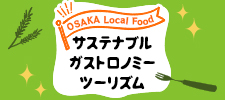Sea and Yamasachi Naniwa Terroir

Osaka Bay is a fish kingdom with the Seto Inland Sea, Japan's largest inland sea.
Osaka Bay was once so rich in fish that it was called the Fish Garden. It is written as ``fish garden'' and is pronounced as ``naniwa''. It is said to be the origin of Naniwa, another name for Osaka. Sea bream and mackerel, conger conger and cutlassfish, sardine and conger eel. The sea was rich with a variety of fish species. In particular, people in Osaka are known for their love of sea bream, and they would serve sea bream with tails on the table at celebratory occasions. In particular, the red sea bream that goes into spawning season during the cherry blossom season is called ``Sakura Tai'' and is prized. Sea bream is delicious and cheap when it's in season, and if you don't have anywhere to throw it away, it's also a fish that fulfills the ``disposal mentality'' of Osaka merchants. A variety of sea bream dishes, such as salt-grilled, coarse-cooked, and bone-steamed sea bream, have been compiled into a book called ``Tai Hyakuchin Ryori'' and remain as part of Osaka's food culture.

Small fish are also abundant, and among them, a type of small shrimp, monkey shrimp (called Jakoebi in Osaka and Tobiara in the Kanto region), is used in the soup stock for summer somen noodles, and in the Senshu region, it is used for the local dish Jakogoko, which is cooked with mizunasu. It is used for. Also, at Kishiwada's Danjiri Festival, which is also known as the Kenka Festival, blue crabs, commonly known as gazami, are an indispensable delicacy. It's even called the "crab festival". Although it temporarily declined due to modernization, more than 200 types of seafood are still landed every day, and they are prized as local seafood at restaurants and sushi restaurants in Osaka.

Tessa Tecchiri
Osaka accounts for 60% of the pufferfish consumption in Japan. Osaka Bay is a treasure trove of fish, also known as Naniwa. Until around the 1950s, large numbers of pufferfish were caught in Osaka Bay. Speaking of blowfish dishes, we think of tessa (fugu sashimi) and tecchiri (fugu hotpot). The name comes from the fact that a poisonous blowfish was hung on a gun that would kill you if you hit it. In the past, it was a common people's taste. Later, in 1945, the ban on eating puffer fish was lifted by Osaka city ordinance. Since then, the number of restaurants that serve puffer fish has suddenly increased.

Sakai specialty conger eel dish
Conger eel, along with sea bream and conger eel, is an essential fish in Osaka's food culture. Longline fishing for conger eel was once popular in Osaka Bay, and the conger eel in the waters near Sakai was particularly famous. Before the war, there were many processors specializing in conger eel in Dejima, Sakai, and it was known as ``Anagoyasuji.'' In Osaka, you can enjoy boxed sushi and oshizushi using ``tsukeyaki'', conger eel bowl, hotpot dishes, chawanmushi, etc. ``Hansuke tofu'', which is made with marinated conger eel head and grilled tofu, is also well known. There are also ``conger eel sushi'' and ``tempura'' made from boiled conger eel. ``Naruto-maki'' is boiled quail eggs wrapped in raw conger eel and simmered in a sweet-salty sauce. There are a variety of dishes such as ``boiled liver with salt'' and ``liver boiled in tsukudani''. The Japanese eel is born in the waters far east of Taiwan, 2,000 km due south of Osaka, and the transparent larvae come here in early spring. It metamorphoses into a young conger eel of about 8 cm, and grows to about 28 cm by the end of the year. The larger they get, the more fat they contain and the tastier they become. The season is around May to June.

Taste of Kansai Hamo
The catch of conger conger is increasing, and they come to Osaka Bay from spring to summer in search of spawning and food. Most return to the open sea in late autumn. Although it is known as a summer fish, it is also in season from autumn to winter, when it actively forages for food after spawning, and its fat gives it a rich flavor. Conger conger live on sandy mud bottoms at depths of less than 100 m along the coast, and are active in shallow waters in summer. They are carnivorous and have large eyes because they search for food at night. Young fish eat small fish, shrimp, and crabs, and as they grow older, they prey on squid, octopuses, and sometimes even conger eels. Conger eel, like eel, has a strong vitality and can withstand long-term transportation while alive. There are famous restaurants in Sennichimae and Dotonbori where you can enjoy delicious conger conger dishes such as live conger conger, conger conger shabu, conger pressed sushi, and conger conger chiri.
Naniwa's "Tai-san"
The glossy red red sea bream is affectionately known as ``Otai-san'' and is a fish loved by Osaka people. This is because of the ingenuity, wisdom, and techniques for distributing live fish unique to Osaka that have been handed down since the era of Toyotomi Hideyoshi. In addition to sashimi and sushi, you can enjoy dishes such as ``Tai Chazuke'' in a relatively casual manner.

“Naniwa traditional vegetables” only found in Osaka
During the Edo period, Osaka was known as the ``nation's kitchen,'' and there were many unique vegetables that were served in people's daily lives. However, as farmland became residential land and eating habits became more Westernized, traditional varieties began to disappear. In recent years, there has been a growing momentum to reconsider these traditional vegetables, and an increasing number of producers are working on discovering and reviving ``Naniwa Traditional Vegetables'' with a focus on Osaka Prefecture. As of 2019, there are 18 “Naniwa Traditional Vegetables” certified by Osaka Prefecture. Kyoto vegetables are famous as traditional vegetables, but if Kyoto vegetables were presented to the Imperial Palace and were prized for their beautiful and elegant taste and appearance, the appearance of traditional vegetables in Osaka was created because the common people simply wanted something delicious. It is characterized by its rustic texture and strong flavor. For example, Tamatsukuri Kuromon Shirori has a long fruit, about 30 cm long. Katsuma pumpkin (Kotsuma pumpkin) is small but lumpy, and actually sticky and sticky. Moriguchi daikon is long and slender, sometimes reaching over 180cm. Kema cucumber is characterized by its chewy texture and strong bitterness. In addition, Kintoki ginseng, Osaka Shirona, Tennoji turnip, Tanabe radish, Bud perilla, Hattori Etsu melon, Torikai eggplant, Mishima dokkatsu, Suita Jiga (kuwai), Senshu yellow onion, Takayama mana, Takayama burdock, Usui fuku bean (light) peas), Namba green onions, etc.
-
 Tradition and history create “delicious!”
Tradition and history create “delicious!”During the Edo period, when Kitamae ships were in active use, kelp harvested in Hokkaido was transported from Shimonoseki via the Seto Inland Sea via the ``Konbu Road'' in the Sea of Japan to the ``nation's kitchen'' of Osaka and Sakai. .
-
 Naniwa's Pintxos - Casual and delicious Konamon & B-class gourmet food
Naniwa's Pintxos - Casual and delicious Konamon & B-class gourmet foodOsakans are full of passion for food. Take care of your ingredients, don't waste them, and don't throw away as much as possible. It takes a lot of time and effort to cook well and eat deliciously.
-
 Naniwa's Artisans: The spirit of craftsmanship that supports food culture
Naniwa's Artisans: The spirit of craftsmanship that supports food cultureSakai, located in the southern part of Osaka and a satellite city of Osaka City, has been transmitting technology and culture to the extent that it is said to be ``Sakai, where everything started.''
-
 Osaka Gastronomy Evolving Quality
Osaka Gastronomy Evolving QualityWhen Toyotomi Hideyoshi built Osaka Castle, Osaka quickly developed as a commercial capital, attracting merchants from Sakai and Fushimi and making it a logistics hub.


